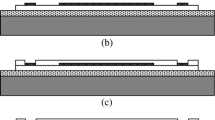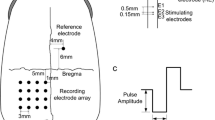Abstract
Visual prosthesis is a potential way to restore partial vision for the patients with degenerative retinal diseases such as retinitis pigmentosa (RP) and age-related macular degeneration (AMD). Optic nerve stimulation with penetrating microelectrode array has been suggested as a possible method for visual prosthesis. The purpose of this study was to investigate the feasibility and basic response properties of cortical responses elicited by optic nerve stimulation with penetrating electrodes in rabbits. In this study, three triangularly or linearly configured platinum–iridium wire electrodes were inserted into the optic nerves of rabbits for electrical stimulation. The charge-balanced current pulses with amplitudes ranging from 10 to 100 μA at 0.5 ms pulse duration were used as the electrical stimuli. The electrically evoked potentials (EEPs) were recorded with a 16-channel silver-ball electrode array in the rabbit visual cortex. Our experimental results showed that the activities of visual cortex could be effectively evoked by the optic nerve stimulation with penetrating electrodes. The threshold of current and charge density to elicit EEPs under optic nerve stimulation at 0.5 ms pulse duration was 20.3 ± 7.5 μA and 37.8 ± 13.9 μC/cm2, respectively. Current stimuli with cathode-first pulses elicited larger cortical responses than that with anode-first pulses. The amplitude of P1 and extent of EEPs increased as the stimulating current amplitude increased, while the latency of P1 decreased. The spatial distributions of multi-channel EEPs in visual cortex demonstrated distinctively different properties under stimulation with different orientations of the stimulating electrodes.







Similar content being viewed by others
References
Zrenner E (2002) Will retinal implants restore vision. Science 295:1022–1025
Humayun MS, Weiland JD, Fujii GY, Greenberg R, Williamson R, Little J, Mech B, Cimmarusti V, Van Boemel G, Dagnelie G, de Juan E (2003) Visual perception in a blind subject with a chronic microelectronic retinal prosthesis. Vision Res 43:2573–2581
Rizzo JF, Wyatt J (1997) Prospects for a visual prosthesis. Neuroscientist 3:251–262
Eckmiller R (1997) Learning retina implants with epiretinal contacts. Ophthalmic Res 29:281–289
Liu W, Vichienchom K, Clements M, De Marco SC, Hughes C, McGucken E, Humayun MS, De Juan E, Weiland JD, Greenberg R (2000) A neuro-stimulus chip with telemetry unit for retinal prosthesis device. IEEE J Solid-State Cir 35:1487–1497
Chow AY, Chow VY (1997) Subretinal electrical stimulation of the rabbit retina. Neurosci Lett 225:13–16
Fang X, Sakaguchi H, Fujikado T, Osanai M, Kanda H, Ikuno Y, Kamei M, Ohji M, Gan D, Choi J, Yagi T, Tano Y (2005) Direct stimulation of optic nerve by electrodes implanted in optic disc of rabbit eyes. Graefes Arch Clin Exp Ophthalmol 243:49–56
Sakaguchi H, Fujikado T, Kanda H, Osanai M, Fang X, Nakauchi K, Ikuno Y, Kamei M, Ohji M, Yagi T, Tano Y (2004) Electrical stimulation with a needle-type electrode inserted into the optic nerve in rabbit eyes. Jpn J Ophthalmol 48:552–557
Chowdhury V, Morley JW, Coroneo MT (2005) Feasibility of extraocular stimulation for a retinal prosthesis. Can J Ophthalmol 40:563–572
Veraart C, Raftopoulos C, Mortimer JT, Delbeke J, Pins D, Michaux G, Vanlierde A, Parrini S, Wanet-Defalque M (1998) Visual sensations produced by optic nerve stimulation using an implanted self-sizing spiral cuff electrode. Brain Res 813:181–186
Li L, Hayashida Y, Yagi T (2005) Temporal properties of retinal ganglion cell responses to local transretinal current stimuli in the frog retina. Vision Res 45:263–273
Brindley GS, Lewin WS (1968) The sensations produced by electrical stimulation of the visual cortex. J Physiol 196:479–493
Dobelle WH, Mladejovsky MG (1974) Phosphenes produced by electrical stimulation of human occipital cortex, and their application to the development of a prosthesis for the blind. J Physiol 243:553–576
Schmidt EM, Bak MJ, Hambrecht FT, Kufta CV, O’Rourke DK, Vallabhanath P (1996) Feasibility of a visual prosthesis for the blind based on intracortical microstimulation of the visual cortex. Brain 119:507–522
Normann RA, Maynard EM, Guillory KS, Warren DJ (1996) Cortical implants for the blind. IEEE Spectr 33:54–59
Humayun MS, Propst R, de Juan E Jr, McCormick K, Hickingbotham D (1994) Bipolar surface electrical stimulation of the vertebrate retina. Arch Ophthalmol 112:110–116
Rizzo JF, Wyatt J, Loewenstein J, Kelly S, Shire D (2003) Methods and perceptual thresholds for short-term electrical stimulation of human retina with microelectrode arrays. Invest Ophthalmol Vis Sci 44:5355–5361
Rizzo JF, Wyatt J, Loewenstein J, Kelly S, Shire D (2003) Perceptual efficacy of electrical stimulation of human retina with a microelectrode array during short-term surgical trials. Invest Ophthalmol Vis Sci 44:5362–5369
Walter P, Szurman P, Vobig M, Berk H, Lüdtke-Handjery HC, Richter H, Mittermayer C, Heimann K, Sellhaus B (1999) Successful long-term implantation of electrically inactive epiretinal microelectrode arrays in rabbits. Retina 19:546–552
Walter P, Heimann K (2000) Evoked cortical potentials after electrical stimulation of the inner retina in rabbits. Graefes Arch Clin Exp Ophthalmol 238:315–318
Chow AY, Chow VY, Packo KH, Pollack JS, Peyman GA, Schuchard R (2004) The artificial silicon retina microchip for the treatment of vision loss from retinitis pigmentosa. Arch Ophthalmol 122:460–469
Zrenner E, Miliczek KD, Gabel VP, Graf HG, Guenther E, Haemmerle H, Hoefflinger B, Kohler K, Nisch W, Schubert M, Stett A, Weiss S (1997) The development of subretinal microphotodiodes for replacement of degenerated photoreceptors. Ophthalmic Res 29:269–280
Zrenner E, Stett A, Weiss S, Aramant RB, Guenther E, Kohler K, Miliczek KD, Seiler MJ, Haemmerle H (1999) Can subretinal microphotodiodes successfully replace degenerated photoreceptors? Vision Res 39:2555–2567
Zrenner E, Gekeler F, Gabel VP, Graf HG, Graf M, Guenther E, Haemmerle H, Hoefflinger B, Kobuch K, Kohler K, Nisch W, Sachs H, Schlosshauer B, Schubert M, Schwahn H, Stelzle M, Stett A, Troeger B, Weiss S (2001) Subretinal microphotodiode array as replacement for degenerated photoreceptors? Ophthalmologe 98:357–363
Stett A, Barth W, Weiss S, Haemmerle H, Zrenner E (2000) Electrical multisite stimulation of the isolated chicken retina. Vision Res 40:1785–1795
Fang X, Sakaguchi H, Fujikado T, Osanai M, Ikuno Y, Kamei M, Ohji M, Yagi T, Tano Y (2005) Electrophysiological and histological studies of chronically implanted intrapapillary microelectrodes in rabbit eyes. Graefes Arch Clin Exp Ophthalmol 244:364–375
Sakaguchi H, Fujikado T, Kanda H, Osanai M, Fang X, Nakauchi K, Ikuno Y, Kamei M, Ohji M, Yagi T, Tano Y (2004) Transretinal electrical stimulation with a suprachoroidal multichannel electrode in rabbit eyes. Jpn J Ophthalmol 48:256–261
Kanda H, Morimoto T, Fujikado T, Tano Y, Fukuda Y, Sawai H (2004) Electrophysiological studies of the feasibility of suprachoroidal-transretinal stimulation for artificial vision in normal and RCS rats. Invest Ophthalmol Vis Sci 45:560–566
Ohta J, Tokuda T, Kagawa K, Sugitani S, Taniyama M, Uehara A, Terasawa Y, Nakauchi K, Fujikado T, Tano Y (2007) Laboratory investigation of microelectronics-based stimulators for large-scale suprachoroidal transretinal stimulation (STS). J Neural Eng 4:85–91
Chowdhury V, Morley JW, Coroneo MT (2005) Stimulation of the retina with a multielectrode extraocular visual prosthesis. ANZ J Surg 75:697–704
Chowdhury V, Morley JW, Coroneo MT (2005) Evaluation of extraocular electrodes for a retinal prosthesis using evoked potentials in cat visual cortex. J Clin Neurosci 12:574–579
Pezaris JS, Reid RC (2007) Demonstration of artificial visual percepts generated through thalamic microstimulation. PNAS 104:7670–7675
Delbeke J, Oozeer M, Veraart C (2003) Position, size and luminosity of phosphenes generated by direct optic nerve stimulation. Vision Res 43:1091–1102
Veraart C, Wanet-Defalque M, Gérard B, Vanlierde A, Delbeke J (2003) Pattern recognition with the optic nerve visual prosthesis. Artif Organs 27:996–1004
Ren Q, Chai X, Wu K, Zhou C, C-Sight Study Group (2007) Development of C-Sight visual prosthesis based on optical nerve stimulation with penetrating electrode array. Invest Ophthalmol Vis Sci 48 E-Abstract 661
Choudhury BP (1987) Visual cortex in the albino rabbit. Exp Brain Res 66:565–571
Walter P, Kisvarday ZF, Gortz M, Alteheld N, Rossler G, Stieglitz T, Eysel UT (2005) Cortical activation via an implanted wireless retinal prosthesis. Invest Ophthalmol Vis Sci 46:1780–1785
Chowdhury V, Morley JW, Coroneo MT (2004) An in-vivo paradigm for the evaluation of stimulating electrodes for use with a visual prosthesis. ANZ J Surg 74:372–378
Grinvald A, Lieke E, Frostig RD, Gilbert CD, Wiesel TN (1986) Functional architecture of cortex revealed by optical imaging of intrinsic signals. Nature 324:361–364
Schwahn HN, Gekeler F, Kohler K, Kobuch K, Sachs HG, Schulmeyer F, Jakob W, Gabel VP, Zrenner E (2001) Studies on the feasibility of a subretinal visual prosthesis: data from Yucatan micropig and rabbit. Graefes Arch Clin Exp Ophthalmol 239:961–967
Wang K, Li X, Jiang Y, Dong J (2007) Influential factors of thresholds for electrically evoked potentials elicited by intraorbital electrical stimulation of the optic nerve in rabbit eyes. Vision Res 47:3012–3024
Banck JB (1975) Which elements are excited in electrical stimulation of mammalian central nervous system: a review. Brain Res 98:417–440
Rattay F, Resatz S (2004) Effective electrode configuration for selective stimulation with inner eye prostheses. IEEE Trans Biomed Eng 51(9):1659–1664
Acknowledgments
The authors thank Yuxiu Liu and Ting Liang for their contributions to the performance of animal surgery. This research is supported by the National Basic Research Program of China (973 Program, 2005CB724302), National Science Fund for Distinguished Young Scholars from the National Natural Science Foundation of China (60588101), Shanghai Pujiang Program (07PJ14050), The National Natural Science Foundation of China (60871091), National High Technology Research and Development Program of China (863 Program, 2006AA04Z356), Shanghai Commission of Science and Technology (064119540).
Author information
Authors and Affiliations
Corresponding author
Additional information
Changsi Cai and Liming Li contributed equally to this work.
Rights and permissions
About this article
Cite this article
Cai, C., Li, L., Li, X. et al. Response properties of electrically evoked potential elicited by multi-channel penetrative optic nerve stimulation in rabbits. Doc Ophthalmol 118, 191–204 (2009). https://doi.org/10.1007/s10633-008-9157-2
Received:
Accepted:
Published:
Issue Date:
DOI: https://doi.org/10.1007/s10633-008-9157-2




